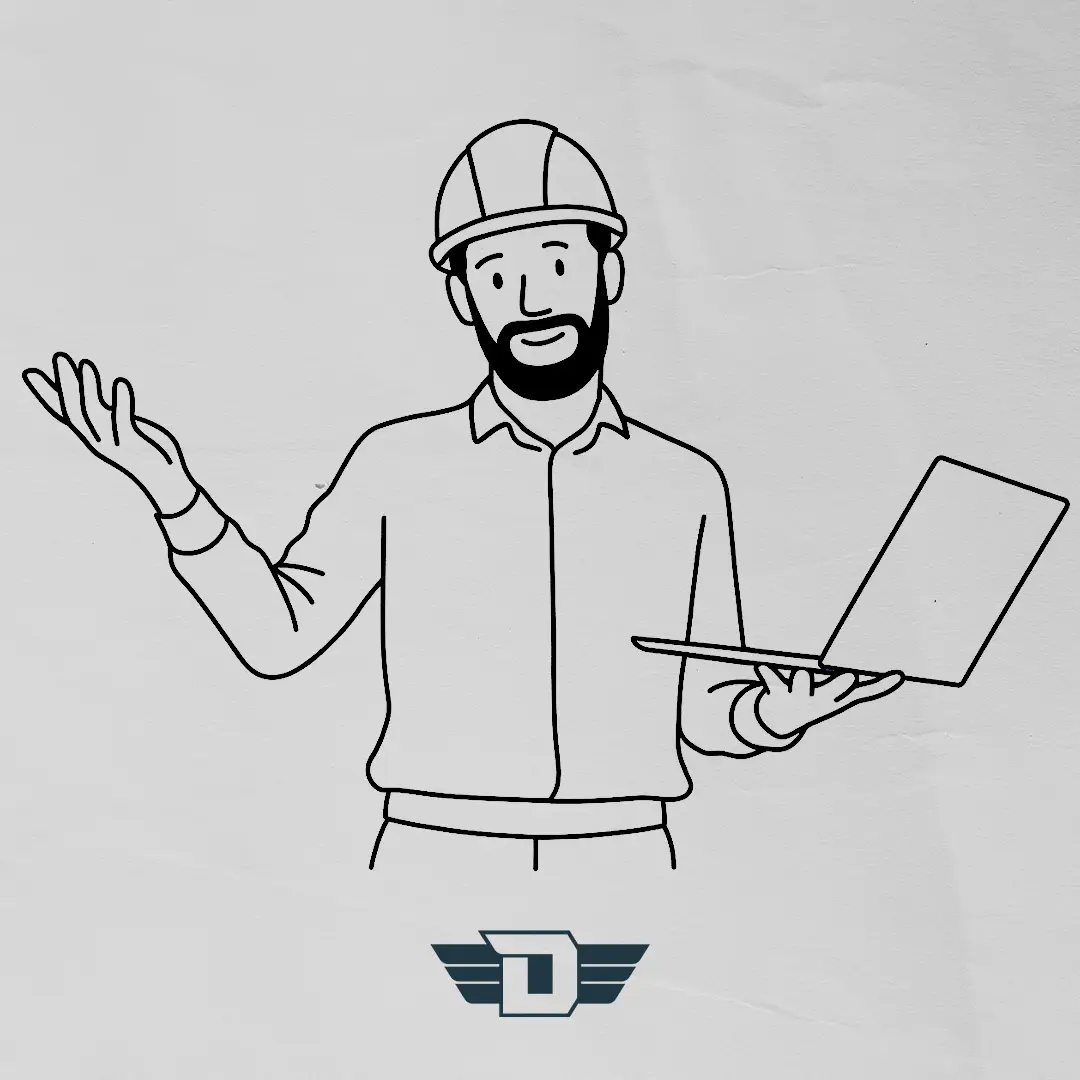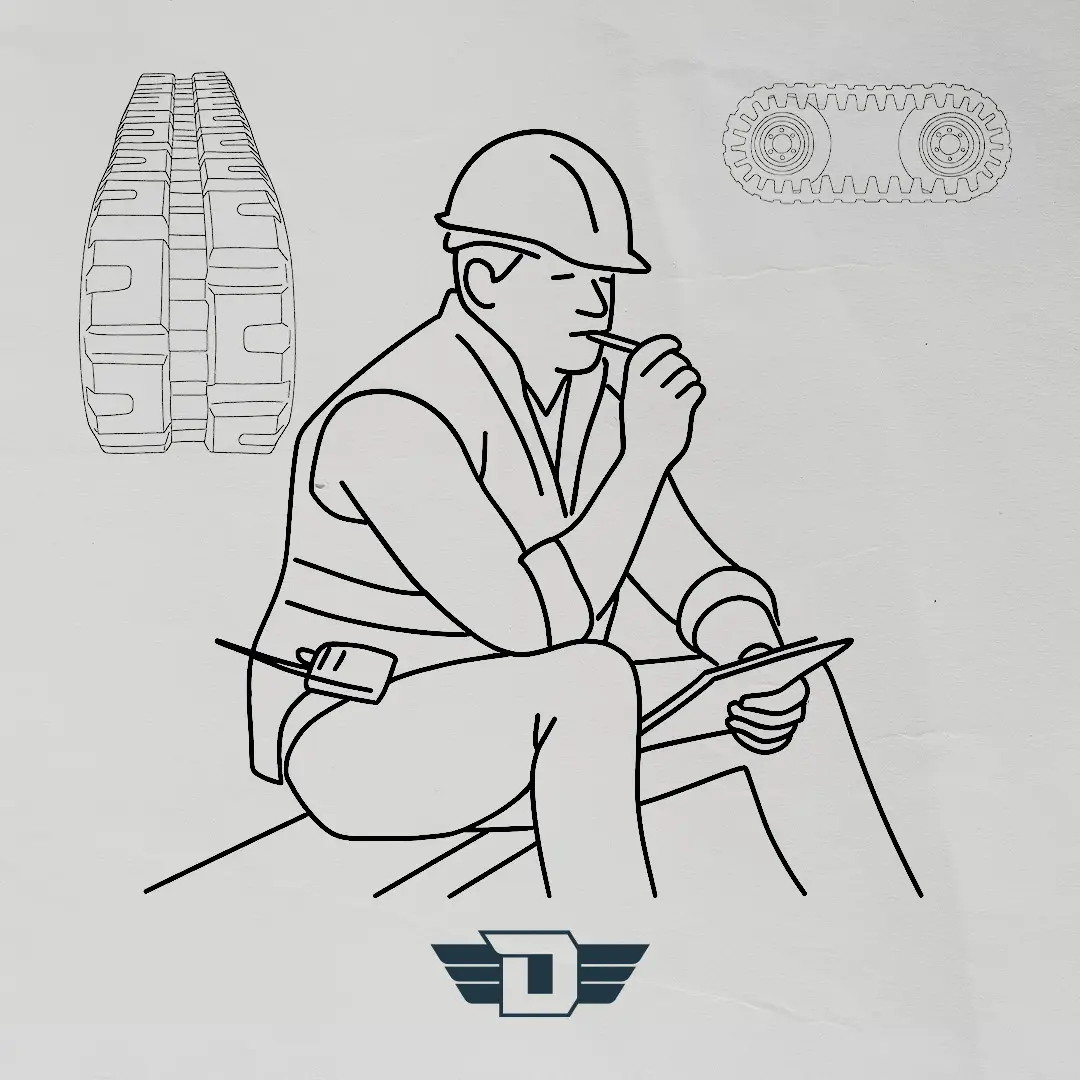- Home
- Buying Guides & Comparisons
- Bobcat Tracks: The Ultimate Buyer’s Guide
Bobcat Tracks: The Ultimate Buyer’s Guide

TL;DR: Key Takeaways on Bobcat Tracks
Bobcat tracks typically last 1,200–1,600 hours with proper care and maintenance.
Track wear comes from heat, friction, and poor operating habits.
Regular cleaning and correct tension extend bobcat tracks lifespan.
OEM tracks fit perfectly; premium aftermarket can match life at lower cost.
Replace bobcat tracks when cracked, de-tracked, or steel cords are exposed.
What Are Bobcat Tracks and Why They Matter

When I first started my company, I didn’t think much about tracks. I figured if they fit, they’d work. Big mistake.
One wet spring, we had a grading job on a residential lot — clay soil, still holding snowmelt. My old skid steer on worn tracks spun like a dog on ice. Lost half a day and burned fuel for nothing.
Bobcat tracks — whether rubber or steel-reinforced — are the muscle and grip your machine needs to actually get work done.
On mud, snow, turf, or loose gravel, they give you traction, stability, and control. CTLs (compact track loaders) ride smoother on soft ground, but a skid steer with the right tracks can still hold its own.
The bottom line: the wrong track costs you time, fuel, and sometimes the job.
Why Getting the Right Track Makes a Difference
When your tracks fit right and match the job, you’ll notice:
Better performance: No slipping, faster cycles, and more push power.
Less wear and tear: Tracks that fit reduce stress on sprockets and idlers.
Operator comfort: Less bounce and vibration means you can run longer without feeling like you’ve been in a paint shaker.
On a downtown demolition job, we swapped to a tread that handled concrete debris better — saved our undercarriage and my chiropractor bill.
Fitment and Sizing — How to Choose the Right Track

Key Measurements You Need to Know
Three specs matter most:
Width (mm)
Pitch — distance between drive lugs
Link count — total lugs around the track
Also, know your guide system. A mismatch here is like wearing two different boots — you’ll feel it fast.
Pro tip:
I once ordered a set of replacement rubber tracks by trusting a seller’s model name alone—but the pitch didn’t match. The track threw mid-load and even wrecked a roller.
From that point on, I always confirmed pitch, width, link count, and guide system using the serial number or service manual—and saved myself costly downtime.
How to Find Your Specs
Here’s how to get the right numbers:
- Look for stamped sizing inside the old track
- Check the machine’s service manual
- Use your serial number + model to find fitment online or call a supplier like Dyne
Common Sizing Mistakes to Avoid
- Don’t rely on model name alone — even similar machines can have different specs.
- Ignoring pitch or guide spacing causes tracking issues and wear.
- Never mix new and worn tracks — it puts uneven pressure on your drivetrain.
Tread Patterns — Matching the Track to the Terrain

Types of Bobcat Track Treads
From my own jobs, here’s what works:
C-Pattern: My go-to for mixed sites. Holds its own on gravel and dirt.
Straight-Bar: Excellent for pushing dirt or snow, but gets chewed up by pavement quick.
Zig-Zag / Multi-Bar: Saved my hide on a sod installation last summer — didn’t leave ruts, even after rain.
Width matters too:
Wide tracks: More flotation on soft ground.
Narrow tracks: Better in tight alleys or hard-packed ground.
How Terrain and Usage Affect Tread Choice
Your tread should match your work:
- Construction or site prep: C-pattern or straight-bar
- Landscaping or turf care: Multi-bar or zig-zag
- Winter work: Zig-zag handles snow better than straight-bar
Track Width and Flotation Considerations
- Wide tracks reduce ground pressure — ideal for soft or loose soils.
- Narrow tracks are better for tight spaces or hard-packed terrain.
If you’re in soft ground or landscaping, go wide. Working on hard ground or doing demo? Stick with standard width.

Let's keep you on track
OEM vs. Aftermarket Bobcat Tracks — What to Consider

OEM Quality and Cost
OEM (Original Equipment Manufacturer) tracks are often made by third parties like Bridgestone — they’re solid, but pricey. You’re paying for the name, not always better performance.
I’ve run both. OEMs are solid but pricey — you’re paying for the name. Premium aftermarket tracks (virgin rubber, continuous steel cords, ISO 9001 certified) can match or even beat OEM life.
What Makes a Premium Aftermarket Track
Look for:
- Virgin rubber (not recycled or filler-heavy)
- Continuous steel cords (no weak overlap points)
- ISO 9001 certification (proven quality systems)
These features make a track last longer and handle stress better.
Choosing a Trustworthy Supplier
Ask yourself:
- Do they offer clear warranty and return policies?
- Do they know your machine model and confirm fit?
- Are they selling rebranded imports or true premium tracks?
Dyne Industries checks every box: expert fitment support, top-grade materials, and responsive Canadian support.
Common Mistakes When Buying Bobcat Tracks

Avoid these costly errors:
- Relying on model name alone — Always confirm pitch, width, and link count.
- Skipping tread considerations — Choose based on your terrain.
- Mixing new and worn tracks — Causes imbalance and wear.
- Ignoring the undercarriage — Worn sprockets or rollers eat up new tracks fast.
- Buying based on price only — Cheap tracks fail early, costing more long-term.
Use Cases — Which Tracks Fit Your Bobcat and Job

Bobcat Models and Matching Track Types
| Bobcat Model | Common Use | Best Track Type |
|---|---|---|
| T190 | Landscaping | Turf, Multi-bar or Zig-Zag |
| T595 | Construction | C-pattern |
| T770 | Demolition | Reinforced Straight |
| T450 | Farming & tight work | Zig-Zag or C-Pattern |
Industry-Specific Use Cases
- Construction: C-Pattern for mixed tasks
- Landscaping: Multi-bar to protect turf
- Agriculture: Wide tracks with self-cleaning tread
Snow Removal: Zig-zag pattern for grip in winter

Let's keep you on track
How Long Do Bobcat Tracks Last?

We dug into multiple reputable industry sources to get a clear picture of how long rubber tracks actually last under varied conditions.
Here’s what we found:
Lifespan of Rubber Tracks: OEM vs. Aftermarket
- Typical rubber track lifespan varies widely—from about 400 to 2,000 hours of use, depending on factors like terrain, operator behavior, and maintenance. 1, 2, 3, 4, 5, 6, 7, 8, 9, 10
OEM Track Performance
- Many sources report OEM tracks usually last between 1,200 and 1,600 hours in standard working conditions.
- Some users have even seen OEM tracks reach 4,000 hours of life, far exceeding average expectations.
Aftermarket Track Performance
- A seasoned fleet technician shared that factory Bridgestone tracks lasted about 1,200 hours, while aftermarket replacements lasted around 600 hours.
- Other sources echo this trend: aftermarket tracks often have noticeably shorter lifespans, though some high-quality versions, like Dyne Industries have the same OEM durability in ideal conditions.
| Category | Typical Lifespan | Notes |
|---|---|---|
| OEM Tracks | ~1,200–1,600 hours | Reliable baseline in normal usage |
| OEM Tracks (some cases) | Up to ~4,000 hours | Exceptional longevity under good care |
| Aftermarket Tracks | ~600 hours | Often significantly lower than OEM |
| Aftermarket (premium/high-end) | 1,000+ hours | With Dyne Industries or under optimal conditions & quality |
| Tracks under abusive use | <500 hours | Can fail prematurely due to misuse |
Factors That Affect Lifespan
- Type of ground you work on
- Operator habits (sharp turns = more wear)
- Undercarriage condition
When to Replace Your Tracks
Look for:
- Cracks or exposed cords
- Chunking or lost lugs
- Vibration or slipping
- Poor ride or traction
How to Get the Most Life Out of Your Bobcat Tracks

Rubber tracks are one of the hardest-working parts of your Bobcat. They carry the machine’s weight, grip the ground, and take every bit of stress from turning, climbing, and pushing.
If you know what causes them to wear out, you can keep them working longer and make better choices when it’s time to buy new ones.
The Science Behind Rubber Track Wear
Research on rubber wear shows it’s not just about total hours.
Tracks wear down when small cracks form in the rubber and spread over time. Heat, friction, and sharp impacts speed up the process.
The type of rubber compound and the way the steel cords are built inside the track can make a big difference in how long they last.
Studies on stress distribution also show that wear is rarely even. The edges and corners of the track take more load—especially during tight turns or when working on hard, abrasive ground.
That’s why you’ll often see one side of a tread pattern wearing faster.
In tests with tracked machines, operators working on softer or mixed terrain with fewer sharp turns saw much slower wear rates than those running in rocky or demolition work.
The takeaway? Where and how you run your Bobcat tracks matters as much as the brand you choose.
Proven Habits That Extend Track Life
The science lines up with what seasoned operators already know: small habits make a big difference.
Avoid constant counter-rotation on hard surfaces. It generates heat and accelerates cracking.
Check track tension often. Too loose and they can slip or tear lugs. Too tight and you strain the steel cords. Use your Bobcat service manual for the correct sag.
Keep them clean. Mud, gravel, or ice buildup changes how the track sits on the rollers, creating uneven stress.
Mix your ground conditions when possible. Switching between pavement and softer surfaces reduces heat buildup.
Choosing the Right Tracks — OEM vs. Premium Aftermarket
Material quality and build are key to long life. OEM Bobcat tracks are designed for a perfect fit and use high-grade rubber and steel cords. Many operators get 1,200 to 1,600 hours from an OEM set with proper care.
Premium aftermarket tracks can be a smart buy if they meet certain standards:
Virgin rubber for consistent wear resistance
Continuous steel cords for strength and stability
Quality certifications like ISO 9001 for manufacturing consistency
These features help resist cracking, maintain proper tension, and wear more evenly—backed up by real-world operator experience and stress modeling research.
The Bottom Line
There’s no fixed lifespan for Bobcat tracks. It comes down to quality, operating habits, and maintenance.
If you run them smart, keep them clean, and buy well-built tracks, you can reach—or beat—the high end of the lifespan range whether you stick with OEM or choose a proven premium aftermarket option.
Track Maintenance Tips to Maximize Lifespan

Daily and Weekly Inspection Routines
- Check for wear, missing lugs, or damage
- Look for loose tension or unusual sag
How to Clean Rubber Tracks
- Wash off mud, gravel, and chemicals after use
- Use a pressure washer to clean guides and undercarriage
Proper Tensioning: How Tight Is Right?
- Aim for 1 to 2 inches of sag in the middle when lifted
- Too loose = de-tracking, too tight = premature wear
Replacing Worn Undercarriage Parts
Bad sprockets or rollers will chew up even the best tracks. Inspect and replace as needed.
Why Choose Dyne Industries for Bobcat Tracks

Expert Fitment Support for 2,400+ Models
We’ll help you find the exact track size using your serial number — no guesswork.
Top-Tier Materials and Track Construction
Our tracks are made with virgin rubber, continuous steel cords, and ISO 9001 certified.
Proven Reliability and Warranty Protection
Backed with a 12-month warranty and 14-day return window.
Fast Shipping and Easy Returns
We ship across Canada and the U.S. — free in Canada, flat rate in the U.S.
Shipping, Returns, and Support: What to Expect

Canada-Wide Free Shipping, Flat U.S. Rate
- Ships same-day if in stock
- Tracking included on all orders
14-Day Return Window for Unused Tracks
- Full refund if unused and uninstalled
- Easy return process
Live Support from Real Track Experts
Need help? Our team works with contractors and operators every day — and we’ll get you the right fit, fast.
Final Checklist — What to Confirm Before You Order
✅ Correct width × pitch × links
✅ Tread pattern matched to terrain
✅ Trusted supplier with warranty
✅ Undercarriage in good condition
✅ Delivery time fits your project needs

Let's keep you on track
FAQs About Bobcat Tracks
With proper care, OEM Bobcat tracks usually last 1,200 to 1,600 hours.
Premium aftermarket tracks can last around 1,000 to 1,400 hours. Harsh terrain, poor maintenance, or bad operating habits can cut that life in half—or more.
Rubber tracks are quieter, smoother, and gentler on turf, asphalt, and concrete. Steel tracks are more durable in demolition or rocky terrain but can damage finished surfaces and ride rougher. For most Bobcat owners who work on mixed or soft ground, rubber tracks are the better choice.
Don’t dump them in a landfill. Many scrap yards, recycling centers, or track suppliers will take old Bobcat tracks for recycling. Some operators cut them into mats for shop floors, ramps, or erosion control.
Check for these signs:
Cracks through the rubber lugs
Steel cords showing
Missing or torn guide lugs inside the track
Repeated de-tracking (coming off the rollers)
Smooth tread that’s lost grip
If you see more than one of these, it’s time to replace your Bobcat tracks.
Follow your Bobcat service manual for the exact sag measurement—usually about 1 to 2 inches between the bottom of the track and the roller when lifted. Too tight strains the cords; too loose risks de-tracking.
Most Bobcat models need grease applied to the track tensioner every 50 to 100 hours of operation, or sooner if you work in wet, muddy, or sandy conditions. This keeps tension consistent and prevents damage.
Small surface cuts or gouges can sometimes be patched with rubber repair kits, but this is only a short-term fix. Once steel cords are exposed or guide lugs are damaged, replacement is the safest and most cost-effective option.
- aftermarket bobcat tracks
- bobcat track buying guide
- bobcat track care
- bobcat track lifespan
- bobcat track maintenance
- bobcat track replacement
- bobcat track tension
- bobcat tracks
- compact track loader tracks
- OEM bobcat tracks
- rubber track repair
- rubber tracks
- skid steer maintenance
- skid steer track guide
- skid steer tracks
Your no-nonsense guide to choosing the right Kubota skid loader. Specs, models, and tips to match your machine to your work.
How to Pick the Best Tracks for Your Skid Steer (Without Guesswork)





